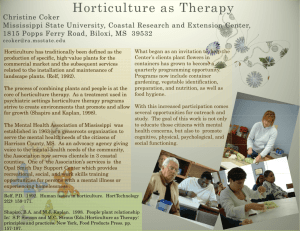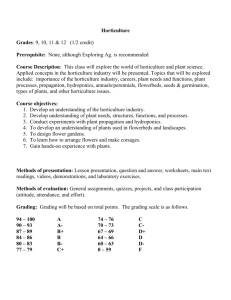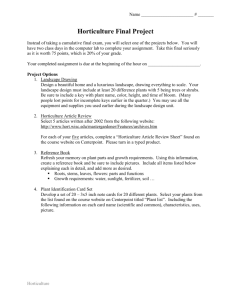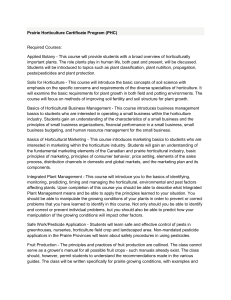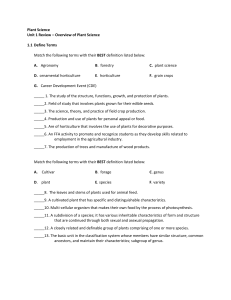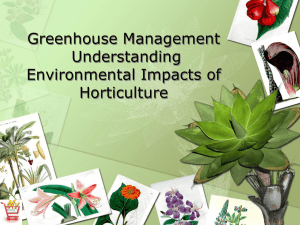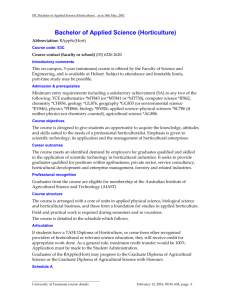PowerPoint
advertisement
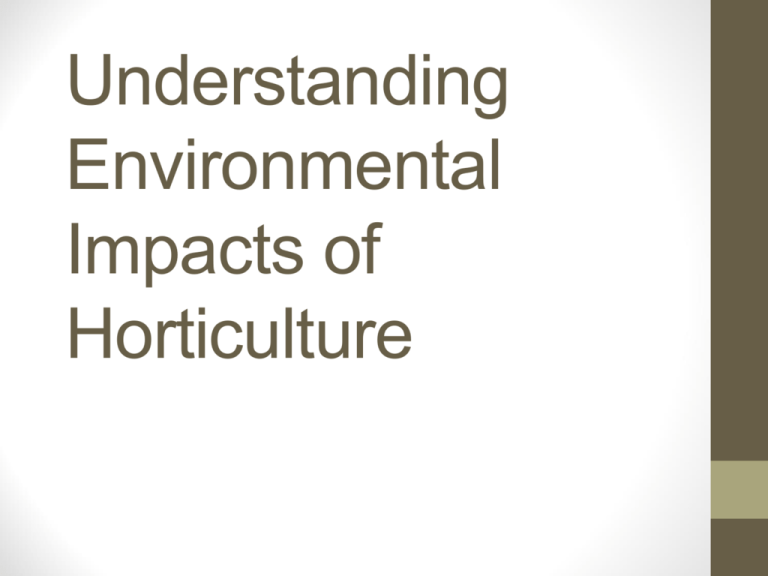
Understanding Environmental Impacts of Horticulture Next Generation Science/Common Core Standards Addressed! • HS‐LS1‐3. Plan and conduct an investigation to provide evidence that feedback mechanisms maintain homeostasis. [Clarification Statement: Examples of investigations could include heart rate response to exercise, stomate response to moisture and temperature, and root development in response to water levels.] [Assessment Boundary: Assessment does not include the cellular processes involved in the feedback mechanism.] • HS‐LS1‐5. Use a model to illustrate how photosynthesis transforms light energy into stored chemical energy. [Clarification Statement: Emphasis is on illustrating inputs and outputs of matter and the transfer and transformation of energy in photosynthesis by plants and other photosynthesizing organisms. Examples of models could include diagrams, chemical equations, and conceptual models.] [Assessment Boundary: Assessment does not include specific biochemical steps.] • HSSIC.B.6 Evaluate reports based on data. (HS‐LS2‐6) Bell Work! • Explain environment and issues related to the environment. • Explain horticulture is beneficial to the environment. • Explain how horticulture can damage the environment. • Identify how natural resources can be affected by horticultural practices. • Identify how chemicals used in horticulture can affected the environment. Terms Abiotic Biotic Condensation Environment Eutrophication Evaporation Habitat Hydrologic cycle Infiltration Intensive land use Macroenvironment Nitrogen Cycle Nonpoint source pollution Point source pollution Pollution Precipitation Transpiration Wetlands Wildlife Interest Approach Brainstorm definitions for the term environment. When several possible definitions are written on the board, look in an encyclopedia or dictionary. How do the class definitions compare with the encyclopedia or dictionary definition? Student Learning Objectives • Explain environment and issues related to the environment. • Explain horticulture is beneficial to the environment. • Explain how horticulture can damage the environment. • Identify how natural resources can be affected by horticultural practices. • Identify how chemicals used in horticulture can affected the environment. What is the environment and what are issues related to the environment? I. An organism’s environment is made up of those factors that affect its life. A. Environment are made up of living, biotic, and abiotic, or nonliving things. Proper horticultural practices can help improve a plant’s macroenvironment and microenvironment . A macroenvironment is the large atmosphere around a plant and the microenvironment is the area immediately surrounding a plant. B. Public demand for a high quality product, growers concerned over how to produce a high quality product at a low cost, and environmental concern have resulted in many emotional environmental issues. 1. Intensive land use involves using production practices on large fields to get top yields. These practices can greatly affect the natural resources in an area by altering the natural yields. 2. The use of integrated pest management is a biological control used to fight pests. Integrated pest management (IPM) is beneficial for the environment. IPM is a strategy that uses a combination of measures to reduce pest damage wit the least disruption to the environment. 3. Biotechnology and genetic engineering have been used to help produce new plant varieties and improve others. People are concerned with the environmental impact of these genetically altered plants. How is horticulture beneficial to the environment? II. Horticulture is beneficial to the environment in many ways. Its benefits can be both personal and biological. A. Plants can be used for personal benefit in recreational settings such as golf courses and public parks. B. Biological benefits of horticulture include the use of plant parts to help prevent erosion, slow water runoff, absorb, control dust, and provide wildlife habitat. C. Landscaping can also help improve the value of real estate by increasing the beauty of an area. How can horticulture damage the environment? III. Many horticultural practices require the disruption of the earth and the application of chemicals. If not applied as directed, these chemicals are considered pollutants. Pollution is a hazard of horticultural practices. A. These practices, and others, can cause harm to the environment if not practiced carefully. Improper management and excessive or improper use of chemicals or water supplies are examples of ways horticulture can damage the environment. B. Pollution occurs when harmful or degrading materials get into the environment. Pollution can be from point or nonpoint sources. 1. Point source pollution comes from sources that are easily identified such as large factories. This type of pollution is easier to control than nonpoint source pollution. 2. Nonpoint source pollution is more difficult to control. Nonpoint source pollution can come from few to many different sources. This type of pollution can occur naturally with rainfall or as a result of human activity such as pesticide poisoning in aquatic animals. Point Source Pollution How can natural resources be affected by horticulture practices? IV. Water resources, wetlands, and wildlife are are all natural resources that can be affected by horticultural practices. A. Water resources are essential to the environment, water is essential for all living things. When water is used, nature has its way of restoring it. The hydrologic cycle and infiltration are two ways nature restores water. 1. The hydrologic cycle is the way the water flows through the environment. Water moves through a series of processes including; precipitation, water deposited on the earth in the form of rain or snow; evaporation, the process of changing from a liquid to a vapor while passing through the air; transpiration, movement of water in vapor form; and condensation, change of water from a vapor to a liquid. Major sources of water in the hydrologic cycle ore oceans, lakes, rivers, streams, groundwater, and reservoirs. 2. Infiltration is the movement of water through the soil. Proper land management practices in horticulture can affect both the quantity and quality of water that will eventually become ground water. Hydrologic Cycle B. Wetlands are an important part of the hydrologic cycle. Wetlands include swamps, bogs, marshes, mores, ponds, or other places where water stands. 1. Wetlands are areas protected by law. Plans are being made or are in place to restore or enhance most wetlands. Wetlands are essential to the environment in flood control, wildlife habitat, and shoreline erosion control. It is important to maintain wetlands when using horticultural practices. 2. Wetland ecosystems can also be used to enhance an environment. They can be used for recreation such as fishing and hunting, or provide beauty and comfort for people to enjoy. C. Wildlife habitats can also be threatened by horticultural practices. Wildlife can be defined as plants or animals that are not domesticated. With planning, it is possible to create areas for wildlife to live. Habitat is the place where wildlife lives in nature. Habitats can be natural, such as a forest or wetland, or man-made, such as golf course or parks. 1. To reduce chemical hazards to wildlife, it is important to understand their habitats. Applications should be made when it will cause the least harm to wildlife. 2. It is also important to use the correct pesticide formulations. Granular formulations can be especially dangerous to birds. How can chemicals used in horticulture affect the environment? V. Fertilizers and pesticides are the two main horticulture chemicals that affect the environment. When used as directed, neither is harmful to humans, plants, animals, or the environment. Used inappropriately, both could be detrimental to living organisms. A. The use of fertilizers in agriculture has been around since agriculture began. From placement fish remains in seed beds, to spreading animal manure on fields, fertilization is often a necessary process. While fertilizers are sometimes needed, they should be used with care. Using excessive fertilizers is both financially wasteful and harmful to the environment. 1. Eutrophication is an overabundance of nutrients in lakes or streams, it is caused by excessive fertilizer running off nearby fields. Eutrophication be harmful to aquatic life because it depletes the oxygen supply in the water. 2. Most fertilizers are high in nitrogen. When needed and used by plants, nitrogen is not harmful to the environment. The nitrogen cycle is the circulation of nitrogen throughout the environment. When excess nitrogen is introduced to the nitrogen cycle and mixed with nitrates found in the soil, the result could be an increase in nitrates found in groundwater. This is a major concern to the health of humans who use groundwater as a source for their drinking water. 3. Phosphorus loss through surface runoff is also an environmental concern. Well-placed turfgrass and ground covers can help reduce phosphorus leaching. B. Pesticides are chemicals used to kill plant and animal pests. When used correctly, pesticides will cause little or no harm. Risk in using pesticide is associated with resides. Pesticide residue has been proven to cause problems such as water contamination, emergence of resistant pest populations, and decline in certain bird population. 1. To reduce the need for pesticides it is important to keep plants healthy. Healthy plants don’t need pesticides, they are able to tolerate low levels of pest-populations. 2. Pesticides enter the environment in many ways. Some are vaporized, others leach through the soil, and others travel in surface runoff. It is important to use pesticides as specifically directed because they decompose slowly in the environment. Review/Summary • What is the environment and what are issues related to the environment? • How is horticulture beneficial to the environment? • How can horticulture damage the environment? • How can natural resources be affected by horticultural practices? • How can chemicals used in horticulture affect the environment? The End!

